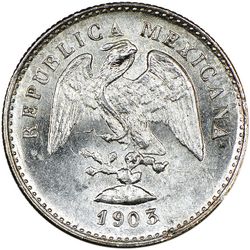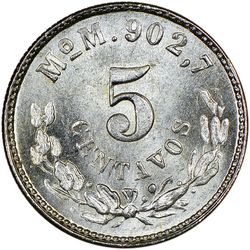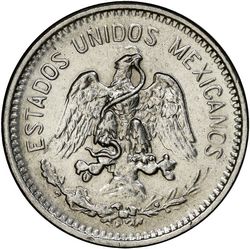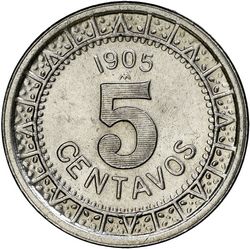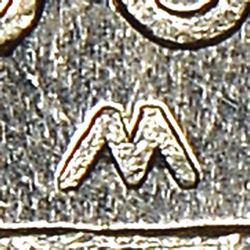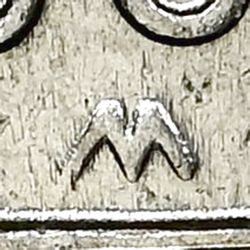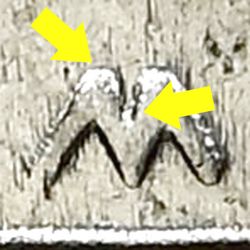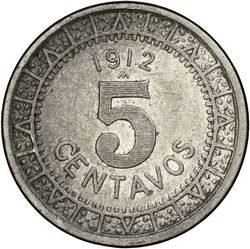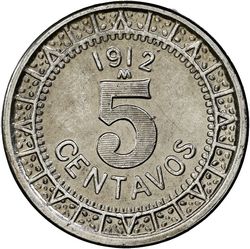Study of the Nickel 5 Centavos (1905-1914)
by Scott Doll
Example of Mexico 2nd Republic 5 Centavos - 1905 MoM Silver (.9027), 14 mm
Struck from 1863-1905
Various mint marks & varying eagle designs can be seen.
Background
The Monetary Reform of 25 March 1905 redefined the design on all the Mexican coinage except for the silver one peso which would continue with the Republic design until 1909. All other denominations would have new designs to include a redesigned obverse forward-facing eagle holding a snake, as well as a new legend which changed from “REPUBLICA MEXICANA” used during the Mexican Republic period to “ESTADOS UNIDOS MEXICANOS” starting with 1905 struck coins in support of the Monetary Reform.
The new 5 centavos would have a story all their own as they would have a different design with an Aztec style geometric border of quincunxes and points, as well as having a different metallic composition (nickel) compared to other denominations struck at the time. In fact, many of the nickel 5 centavos would not even be struck in Mexico, but more on that in a moment. The Mexican Mint made the decision to move away from silver-based 5 centavos used during the Republic period and shifted towards a pure nickel metallic content for the new coins. Although the decision was a good one from a fiscal perspective as nickel was a much cheaper alternative, it did have other issues since pure nickel was not durable as it corroded badly which caused the coins to degrade quickly over time. I am sure the mint also thought they were helping the masses since it was believed that the old silver 5 centavos were too small and inconvenient, therefore a new larger coin was needed. I am certain that, although the silver 5 centavos may have been inconvenient, the people were less thrilled using the nickel replacement as the intrinsic value was not comparable to silver. I must believe that most people probably felt like they were being cheated by the government.
Production
After the closing of the last of the private mint contracts or chartered mints from the Republic period, all coinage operations moved to the mint located in Mexico City which assumed full responsibility for the striking of all coins needed within the country. With that said, they also knew that they would need help from other mints since the demand was greater than their ability to strike all the newly designed coins starting with the 1905 dated coins. The mint that was chosen to help strike the new 5 centavos coins was The Mint, Birmingham Ltd. or Heaton Mint located in Birmingham, England. This was a good choice as this company produced coins for many foreign nations including France, Italy, China, and much of the British Empire during the 19th century and now Mexico would be added to that list.
The Mexican Mint did not contract all 5 centavos to be struck at the Birmingham Mint but did allow them to strike a vast majority of the coins which would be identical in design and composition to the ones struck at the Mexican Mint. A Guide Book of Mexican Coins, 1822 to Date by T. V. Buttrey and Clyde Hubbard state the Birmingham Mint struck a large portion of the 1906 and 1911 coins, as well as all the 1907-1910 coins. Other numismatic scholars also believe that some of the 1914 coins were struck in England, however some reports have stated that the bulk of those coins were never delivered. Whatever the case, it is easy to see that many of the 33 million coins were not struck at the Mexican Mint which might help explain why so many different varieties exist with the date and mint mark designs.
Example of Mexico 20th Century 5 Centavos - 1905 M Pure Nickel, 20 mm
Struck from 1905-1914
All coins have a “M” mint mark.
The companies who were contracted for the new pure nickel planchets include several from within the United States, as well as one from within Europe. The Scovill Manufacturing Company of Waterbury, Connecticut and the Coe Brass Manufacturing Company of Torrington, Connecticut provided the bulk of the planchets throughout the striking of this issue, while the Arthur Krupp Company of Berndorf, Austria helped with the supply for the 1913 and 1914 coinage.
Variety Overview
The varieties which have been documented or examined for this series include differences with the mint mark, as well as the date. Date varieties include regular, narrow, and wide dates, as well as overdates. The last area of discussion involves repunched date digits.
Upon closer examination, the mint marks are a bit more intriguing as there are different letter “M” designs used throughout the series. Since most prior analysis has described the mint marks as either a large mint mark or small mint mark, I feel it is worth a closer look at these as there is much more to be seen by doing an in-depth analysis of the letter style itself. Now let us begin.
Mint Mark (MM) Varieties
Even though we previously stated that some of the coins were struck in England, all coins bear the Mexico mint mark “M”, and nothing is currently known as a way to distinguish, with a high level of certainty, any of the differences between the various strikes in Mexico and those from England. While doing my analysis, I have identified and documented at least five different, distinct mint mark designs or styles. I will admit that some of the differences between them are very subtle, but after looking at these in enough detail, it is relatively easy to distinguish each.
MM Style #1 (Regular “M”)
This is the easiest of the various mint marks to identify since it has the most normal looking “M” within this series. Straight even lines with slightly rounded points on most examples. The top indentation is also well pronounced and has the shape of a large “V”. Even with subtle differences, most mint marks between the two years struck are not that different. This mint mark is arguably one of the most common seen throughout the series due to the high mintage of 1905 and 1906 which had a total mintage of 12,034,560, or approximately one-third of the total series. This mint mark can be found on selected 5 centavos from 1905 and 1906.


Mint Mark Style #1 Regular “M”
Key identifiers for this variety.
The top notch is relatively deep and shaped like a large “V”.
The bottom arches are tall, balanced and they are about the same height on both right and left sides.
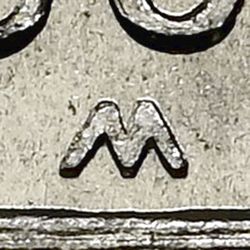
1905 1906
NGC #2824910-004 (MS 62 ) NGC #4702735-006 (MS 64)
MM Style #2 (Notched “M”)
The notched “M” is also a relatively easy variety to identify as it has a clearly visible notch at the base of the upper recessed area of the letter. Where MM Style #1 (Regular “M”) looks like a letter “V” within that area, this variety looks like a narrow rectangle or “U” shape where the lines are almost vertical on either side of the recessed area in question. The top two parts of the letter are also very large and bulky looking compared to MM Style #1. It almost looks like the design is incomplete and may have been hastily prepared by the mint worker. Although obviously different in appearance within the area of the notch, I believe this is most likely an early die design or possibly a reworking of MM Style #1 since all the rest of the letter is almost identical. This mint mark can only be found on the selected 5 centavos from 1905.


Mint Mark Style #2 Notched “M”
Key identifiers for this variety.
The top notch is relatively deep and shaped like a large “U” and displays vertical walls on both sides.
The bottom arches are tall, however the left side is slightly higher than the one on the right.
1905 Mint Mark Close Up
NGC #6205420-004 (MS 64) Pointers to the notch and bulky top.
MM Style #3 (Prominent “M”)
MM Style #3 (Prominent “M”) is yet another mint mark style which is relatively easy to identify. It has bold, symmetrical, straight lines throughout. It also has an ever so slightly higher point on the upper left part of the letter. This mint mark style is also slightly larger than all the other mint marks from this series. Many, but not all, examples also show what appears to be a slight doubling on small portions of the letter, however this is most likely a repunched or retooled letter which occurred during die creation. This mint mark style can only be found on selected 5 centavos from 1912 and 1913.

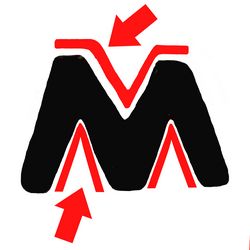
Mint Mark Style #3 Prominent “M”
Key identifiers for this variety.
Thick lettering.
The top portion of the letter has flat tops, and the left side is slightly taller than the right side. The center indentation is shaped like a large “V”.
The bottom arches are tall, however the left side is slightly higher than the right side.
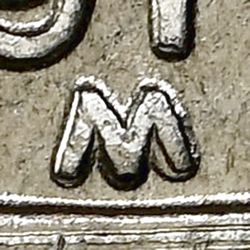
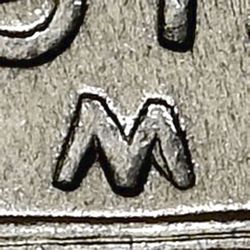
1912 1913
NGC #2724960-003 (MS 63) NGC #2724957-010 (MS 63+)
MM Style #4 (Rounded “M”)
MM Style #4 (Rounded “M”) is quite different than the previously reviewed mint marks. This mint mark design has a somewhat erratic, rounded, and clumpy looking appearance. It is also slightly smaller or fl atter compared to the previously discussed styles. Note the overall flattened shape and the rounded top of the letter are the easiest identifiers for this style. This mint mark style can be found on selected 5 centavos from 1906, 1910, 1911 and 1914.

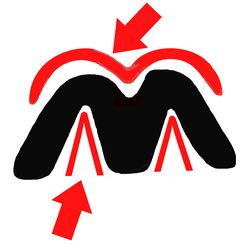
Mint Mark Style #4 Rounded “M”
Key identifiers for this variety.
The top and sides of the letter are rounded. The top indentation is very small and not easily seen on some coins.
The bottom arches are shorter than the other mint marks and the overall appearance of the mint mark is relatively fl at looking..
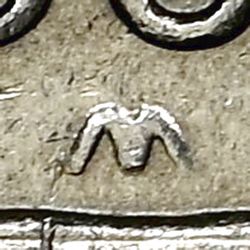
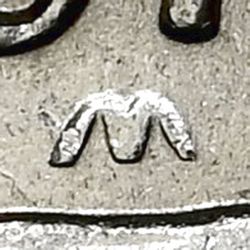
1906 1910
NGC #6435414-014 (MS 65) NGC #2843308-002 (MS 65)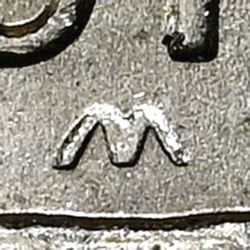
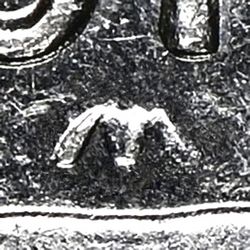
1911 1914
NGC #2736257-009 (MS 64+) NGC #2858944-001 (MS 63)
M Style #5 (Bold “M”)
Like with MM Style #1 (Regular “M”), the mint mark style on MM Style #5 (Bold “M”) can be slightly difficult to distinguish since it has somewhat similar characteristics to what is seen on MM Style #1. However, upon closer examination, this mint mark is quite different since the upper indentation in the center is very shallow and shaped like a small “v” which makes that feature the easiest identifier to distinguish from MM Style #1 which looks like a large “V”. MM Style #4 (Rounded “M”) also has a very small indentation, however it is much more rounded and slightly flatter in overall appearance than what is seen on MM Style #5 which has straighter, more even lines and a much bolder looking appearance. MM Style #5 is one of the most common of all the mint marks observed within this series and can be found on six of the nine years this coin was struck. This style can be found on selected 5 centavos from the years 1907, 1909, 1911, 1912, 1913 and 1914.

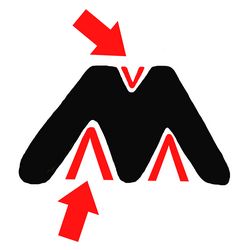
Mint Mark Style #5 Bold “M”
Key identifiers for this variety.
The top notch is relatively shallow and shaped like a small “V”.
The bottom arches are tall, balanced and the left side is slightly higher than the one on the right side.
Thick and bold letter.
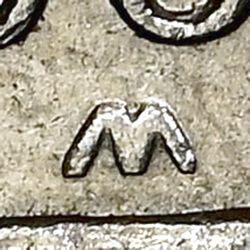

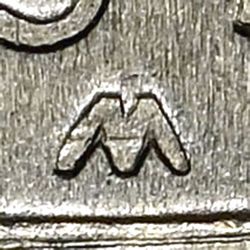
1907 1909 1911
NGC #4432193-004 (MS 64) NGC #2829189-003 (MS 63) NGC #5939683-020 (MS 65)
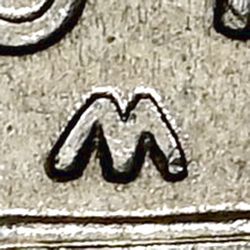
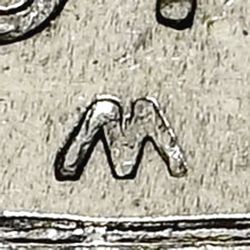
1912 1913 1914
NGC #2820532-005 (AU 55) NGC #6435219-001 (MS 66) NGC #2724957-011 (MS 64)
There is one additional entry that I would like to add to the MM Style #5 section. Although it is not a different mint mark variety, this mint mark can best be described as a sub variety of MM Style #5 as it has an M/M over mint mark that is seen as doubled. Since it appears to be a part of the actual die, it is most likely a repunched letter “M” and not something that was caused as part of the striking process.
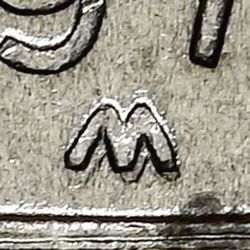
1913 (M/M)
NGC #2822574-005 (MS 64)
Date Varieties
If the review of mint marks was not exciting enough, let us now take a more in-depth look into some of the various date varieties. This will include a review of what I describe as date placement varieties, overdates and finally a review of selected repunched date digits.
Date Placement
Like the mint mark section, there are several different varieties associated with the date. The first group to be reviewed involves date placement. These will be classified as regular, narrow, or wide date. Since the date digits were manually punched by hand by the mint workers responsible for die creation, then it is easy to see how these different date placements occurred.
1905, 1907, 1909, 1910 & 1912 Regular Date Placement
The following are what I reference as coins which have a regular date placement. There will be subtle differences between each year, however these generally fall somewhere in between what are described as a narrow or a wide date. More on those in a moment as each of those can be attributed by counting the small denticles on the surrounding border design above the date.
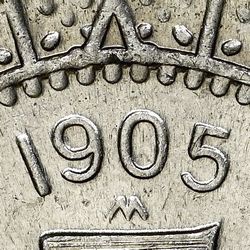
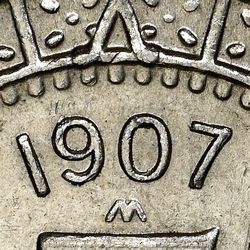

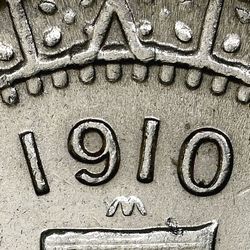
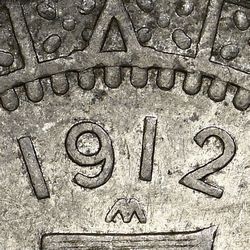
1906 Narrow (Upright) & Wide (Inclined) Date

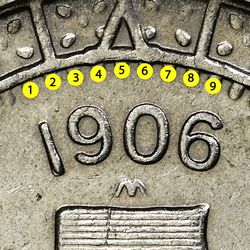

1906 Narrow Date or Upright “6”
MM Style #4 (Rounded “M”)
NGC #6435414-014 (MS 65)
The narrow date variety is spaced with a total of 9 denticles which starts from the top tip of first “1” to the top portion of the “6” which aligns just before the ninth denticle. This date can also be described as the upright “6” variety.
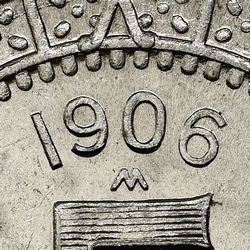
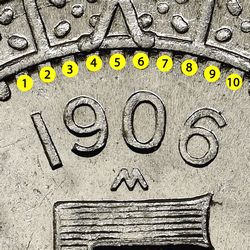
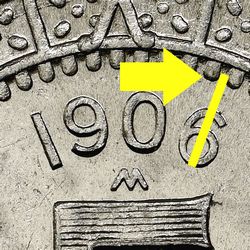
1906 Wide Date or Inclined “6”
M Style #1 (Regular “M”)
Ex. NGC #4702735-006 (MS 64)
The wide date variety is spaced with a total of 9 ½ denticles which starts from the top tip of first “1” to the top portion of the “6” which aligns just past the ninth denticle.
The date can also be described as the inclined “6” variety.
Before I begin the next section, which will outline additional narrow and wide date varieties within this series, I would like to say that counting the small denticles, although very tedious, is the best, most precise way to distinguish between a narrow and a wide date. However, it is not the only way to identify the date placement variety for this series. The previously discussed mint marks are the other way to help distinguish the date placement variety since each one of the narrow and wide dates have different style mint marks. Although previously discussed, the 1906 narrow and wide date can best be described as upright or inclined “6” since the denticle count is so close in total number (9 vs 9 ½), plus it is much easier to identify the placement of the “6”.
1911 Narrow & Wide Date
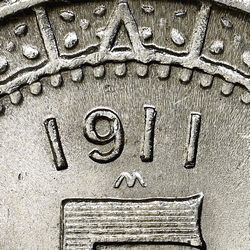
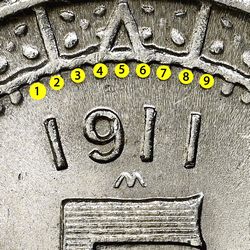
1911 Narrow Date
MM Style #4 (Rounded “M”)
NGC #2736257-009 (MS 64+)
The date is spaced within 9 denticles from the top tip of first “1” to the top tip of the last “1”.
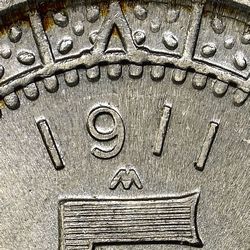
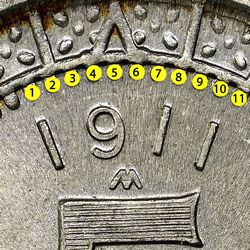
1911 Wide Date
MM Style #5 (Bold “M”)
NGC #5939683-020 (MS 65)
The date is spaced within 10 ½ denticles from the top tip of the first “1” to the top tip of the final “1” which extends just slightly past the tenth denticle.
1913 Narrow & Wide Date

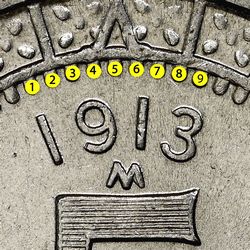
1913 Narrow Date
MM Style #3 (Prominent “M”)
NGC #2724957-010 (MS 63+)
The date is spaced within 9 denticles from the top tip of the first “1” to the top portion of the “3”.
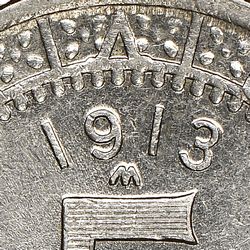

1913 Wide Date
MM Style #5 (Bold “M”)
NGC #2850033-004 (MS 63)
The date is spaced within a total of 10 ½ denticles which starts with ½ way point of the denticle just before the top tip of the “1” and to the top portion of the “3”
Although not photographed within this article, Carlos Amaya in his book, Illustrated Price Guide of the Modern Mexican Coins 1905 to Date describes a very wide date or “Far Away 3” variety which occupies 11 total denticles. This date placement variety is viewed to be very scarce.
1914 Narrow & Wide Date

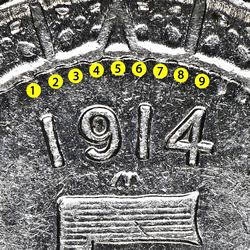
1914 Narrow Date
MM Style #4 (Rounded “M”)
NGC #2858944-001 (MS 63)
The date is spaced within a total of 9 denticles which starts from the tip of first “1” to the top tip portion of the “4”.
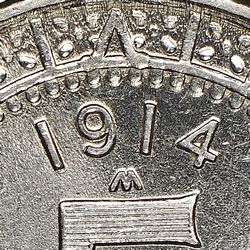
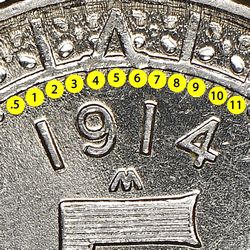
1914 Wide Date
MM Style #5 (Bold “M”)
NGC #2850033-005 (MS 64)
The date is spaced within a total of 11 denticles which starts just slightly to the left side before the first denticle at the top tip of the first “1” and just past the tenth denticle which is just beyond the top tip of the “4”.
1906/5 Overdate
The most important variety within the 5 centavos series is arguably the 1906/5 overdate which until recently was the only known overdate from within the series. Note the little protrusion on the upper left side of the “6” digit. There is also a faint vertical line down the left center portion of the digit. This vertical line attribute is not easily seen without a loupe. The 1906/5 overdate has a MM Style #1 (Regular “M”). This coin is quite scarce and one of the key coins within the series.
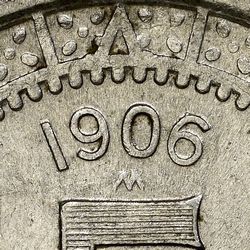

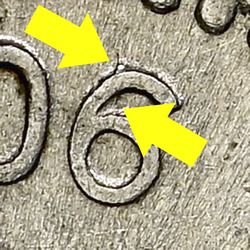
1906/5
NGC #2820532-003 (MS 61)
1913/2 Overdate
The 1913/2 overdate is the most recent variety discovery from within this series. The NGC Census shows a total population of only one which has a grade of MS 62. The coin has a MM Style #3 (Prominent “M”) which seems reasonable since this mint mark can also be seen on selected 1912 dated 5 centavos. This variety is believed to be very scarce.
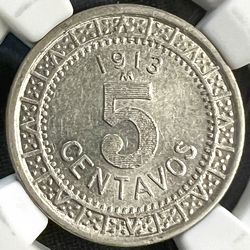
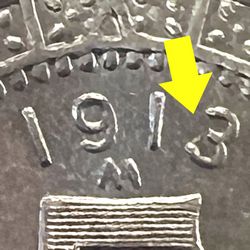
Photo courtesy from an anonymous collector.
Repunched Date Digits
The next section is going to highlight a small sampling of some of the known repunched date digits which have been documented during my analysis of this series. This is by no means a complete list and I am certain there are many more to be discovered and documented.
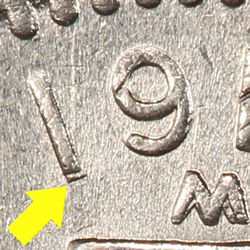
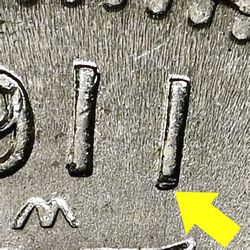
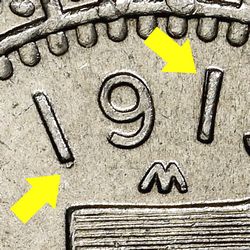
1913 (1/1) first digit 1911 (1/1) last digit 1913 (1/1) & (1/1)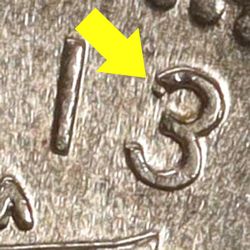
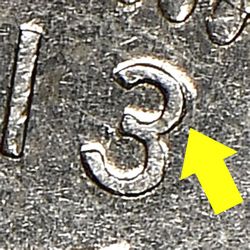
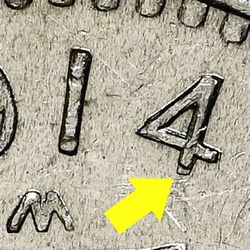
1913 (3/3) 1913 (3/3) 1914 (4/4)
1912 Small & Large Mint Mark
Although I believe that I adequately covered the different mint mark styles to include those for 1912 dated coins, I feel that further review of that date is warranted since that particular year has been well documented in various publications, as well as through variety attribution with the third-party grading agencies as having two different mint mark varieties, one being the “large mint mark” and the other described and labeled as the “small mint mark”. Upon closer examination, the 1912 small mint mark is simply MM Style #5 (Bold “M”) which is the same as what is seen on other selected coins from other years like 1907, 1909, 1911, 1913 and 1914, while the large mint mark variety is MM Style #3 (Prominent “M”) which can also be seen on some 1913 dated coins.
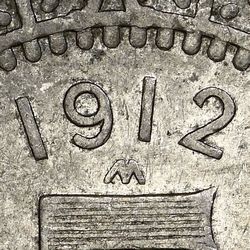
1912
MM Style #5 (Bold “M”)
or Small Mint Mark
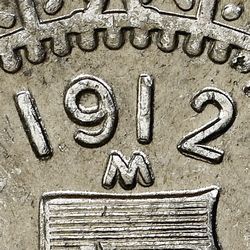
1912
MM Style #3 (Prominent “M”)
or Large Mint Mark
Rarity
This series is one that is not highly collected or sought out by today’s collectors, however those that do collect these coins fully understand how difficult it can be to find specimens in uncirculated condition. Most available for sale in the market are very worn or found in corroded and pitted condition due to their pure nickel content. This is generally true for all dates, but there are several which are more difficult to locate in any condition which includes 1912 as the scarcest followed closely by 1909 dated coins. I would also include the 1906/5 overdate, as well as the previously undocumented 1913/2 overdate within that group since those varieties appear to be extremely rare in any grade. The next tier of scarce dates includes 1905 which is also the first date of the series, followed closely by 1906,1910 and 1911. Last but not least includes 1907,1913 and 1914 as the most common dates. Regarding 1913 and 1914, one would think these to be very scarce dates due to their overall low mintages, however that has not been the case as they do often show up in high grade. Although I have not performed a detailed study of the rarity of the various mint mark styles, I personally feel that MM Style #2 (Notched “M”) and MM Style #4 (Rounded “M”) are the scarcest, followed closely by MM Style #3 (Prominent “M”) and finally MM Style #1 (Regular “M”) and MM Style #5 (Bold “M”) as the most common. Further study will be needed to confirm my opinion.
Series Chart of Dates, Mintages, Mint Marks & Date Placement
The following chart is a summary of all the dates within the series to include the associated mint mark style, as well as the appropriate date placement variety. The repunched date varieties are excluded from this chart due to the large number of possible varieties available.
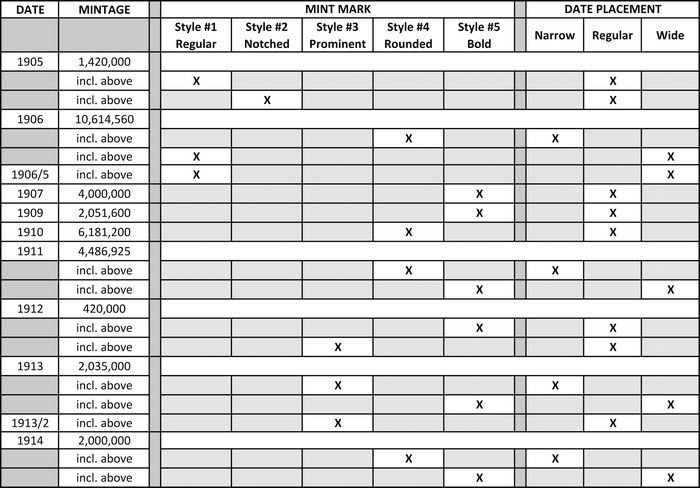 NOTE: Birmingham Mint reportedly struck five million pieces with a date of 1914, however the Mexican Mint has no record of receiving them. If fully or partially delivered, 1914 total mintages would most likely be higher than what is currently stated in the mintage report.
NOTE: Birmingham Mint reportedly struck five million pieces with a date of 1914, however the Mexican Mint has no record of receiving them. If fully or partially delivered, 1914 total mintages would most likely be higher than what is currently stated in the mintage report.
Summary
Although the pure nickel 5 centavos is not an overly beautiful coin and does not have a fancy design element, it does have a certain appeal and fascination to some collectors. After all, it was the first, as well as the only, coin minted in modern Mexico with a pure nickel planchet. Future 5 centavos issues would be struck on copper-nickel, bronze, brass, and stainless steel planchets. Also, it is the first 5 centavos to be struck after the 1905 monetary reform. Lastly, these little pieces look quite fl ashy and lustrous if found in very high grade or brilliant uncirculated condition. Unfortunately, most of the coins are not easily found in that condition today, therefore they can be quite scarce and expensive when found. It is my hope that all the information and details outlined in this article, as well as the cross-reference chart will be helpful to not only die-hard collectors of this series, but also any new or occasional collector who has yet to get deeply engaged with this series. Happy Hunting!
References:
Amaya G., Carlos Abel. Illustrated Price Guide of the Modern Mexican Coins 1905 to Date. Monterrey, NL México, 2008. Print.
Bailey, Don, and Lois. Whitman Encyclopedia of Mexican Money, Volume 2: Modern Coins of Mexico, 1905 to Date. Atlanta, GA: Whitman Publishing, LLC, 2015. Print.
Buttrey, Theodore V., and Clyde Hubbard. A Guide Book of Mexican Coins, 1822 to Date. 6th ed. Iola, WI: Krause Publications, 1992. Print.
Harper, David C., Harry Miller, and Thomas Michael. 2013 North American Coins & Prices: A Guide to U. S., Canadian and Mexican Coins. Iola, WI: Krause Publications, 2012. Print.

